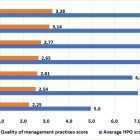What has happened in the popular literature these past years? Why are managers continuously denounced in these magazines and blogs and put aside as being non-relevant or even detrimental to the performance of an organization? Since the beginning of modern economic science management has been seen as being an important, and often the most important, factor for explaining performance differences between organizations and even countries. I therefore urge the authors of these popular stories to not only delve in managerial and economic history before they start writing, but to also take notice of modern day academic research. For instance, in the past years Nicholas Bloom and John Van Reenen have done excellent work researching worldwide the effect of operational management practices on the productivity and profitability of in particular production companies. These so-called social techniques differ from the well-known traditional production technologies in the sense that they mostly have to do with influencing the behavior of people in the organization. Innovation in these social techniques is increasingly seen as being crucial for the development of not only organizations but also of industries and countries.
One could argue, quite convincingly, that the high performance organization (HPO) framework is also a social technique. After all, it deals with creating a mindset and way of working in the organization that makes people want to become high-performing and then start acting accordingly. This behavior causes an organization to be(come) high-performing and achieve better organizational performance than its competitors. I was therefore curious to see whether the scores that Bloom and colleagues measured for the quality of operational management practices in various countries would match with the scores we at the HPO Center have collected worldwide on the high-performance level of organizations. For this purpose, I delved in the HPO database and extracted the scores for the production and manufacturing companies. To be comparable with the data of Bloom et al. I only took data for countries which have been measured by Bloom et al. and which in the HPO database had comparable numbers of respondents from production and manufacturing companies; both a lower number or a very high number of respondents would potentially give too many outliers. I then made a ranking from Bloom et al. ‘quality of management’ countries’ scores (which I took from Dieteren et al.) and from the overall average HPO score per country, the result is depicted in Figure 1.
Figure 1: The quality of management practices (measured on a scale of 1-5) scores and the HPO scores (scale 1-10) for selected countries
It is quite obvious from Figure 1 that there is a similar pattern in the ranking of countries according to the ‘quality of management’ scores and according to the average HPO scores. This should come as no surprise. When looking how Bloom et al. measure ‘quality of management’ the reason becomes obvious. They measure along four dimensions: the way in which companies organize and improve their activities and operations (such as applying lean management), which has a relation with HPO factor Continuous Improvement & Renewal; the goals set by companies which should be long term and which link with ambitious but achievable short-term performance measures, which has a relation with both HPO factors Long-Term Orientation and Continuous Improvement & Renewal; the degree in which companies systematically collect and analyze performance data to initiate improvements, again this has a relation with HPO factor Continuous Improvement & Renewal; and personnel management, which can be linked to various characteristics of HPO factors Employee Quality and Management Quality.
Granted, the ‘quality of management’ indicators are a subset of the HPO characteristics which are more encompassing about what an organization and its managers have to do to become HPO. But it is interesting to see that both Bloom et al.’s research and my research have the same outcome: management matters! In my forthcoming book High Performance Managerial Leadership: best ideas from around the world (Praeger, April 2020) I discuss the techniques and behaviors managers can apply to make sure that they are and remain the decisive factor for the success of their organizations.
More information in English:
- Nicholas Bloom and John Van Reenen (2007) Measuring and explaining management practices across firms and countries, The Quarterly Journal of Economics, Vol. 122 No. 4, pp. 1351–1408.
- Nicholas Bloom, N. en John Van Reenen (2010), Why do management practices differ across firms and countries?, Journal of Economic Perspectives, Vol. 24 No. 1, pp. 203–224.
- Rafaelle Sadun, Nicholas Bloom and John Van Reenen (2017), Why Do We Undervalue Competent Management?, Harvard Business Review, September-October
More information in Dutch:
- Jadé Dieteren, Jesse Groenewegen, Sjoerd Hardeman, Harry Garretsen, Lotte de Haan en Janka Stoker (2018), Managementkwaliteit in Nederland gemeten, Economisch Statistische Berichten, september




